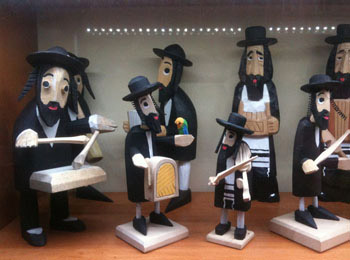MONTREAL — Wooden figurines of stereotypical Jews have been commonplace in Poland almost forever and, in the past couple of decades, have been filling the shelves of shops catering to tourists, albeit in a gentler form.
Poles traditionally kept these “zydki” (a diminutive for Jews) in their homes for good luck.
In times past, their carvers not only exaggerated supposedly Jewish features, but some were clearly inspired by age-old antisemitism, associating Jews with money-grubbing or attempting to find humour by including pigs with them.
Concordia University professor Erica Lehrer has been studying the evolution of this folk art since the 19th century, trying to understand their enduring popularity. The destruction of Polish Jewry did not mean the end of the production and consumption of the knick-knacks, but the reasons changed.
During the Communist era, the Jewish figurines were adopted by the Polish democracy movement as a form of resistance against a regime that ignored the Holocaust.
After the fall of communism, enterprising Polish artisans realized there was a market for these figurines among the growing number of tourists, Jewish and non-Jewish.
The artisans adapted the way they made them to avoid offence. Nowadays, the figurines are more nostalgic, rather than pandering to crude ideas about Jews.
An associate professor in the history, sociology and anthropology departments of Concordia, Lehrer holds the Canada Research Chair in Post-Conflict Memory, Ethnography and Museology.
She has launched a research project designed to encourage an intercultural dialogue on the meaning of these figurines in Poland’s continuing self-examination of its Jewish past and the revival of interest in Jewish culture in a country where there are very few Jews today.
“Jewish figurines have a long history in Polish culture,” she said. “They have played different roles as Polish culture and society have changed.
“How do we – and how might we – look at these figurines? What images and experiences do different audiences bring to them?”
Answering these questions is the goal of the project, based at Concordia’s Centre for Ethnographic Research and Exhibition in the Aftermath of Violence, which she directs.
Lehrer is curator of the exhibition Souvenir, Talisman, Toy: Jews for Hearth and Home, taking place at Krakow’s Seweryn Udziela Ethnographic Museum from June 25 to July 14, during the city’s 23rd Jewish Culture Festival.
In Polish and English, the exhibition tells how varying cultural, religious, economic and political factors have influenced how these figurines have been created and marketed.
Most of the more than 100 figures on display are coming from private collections in Poland, with some from abroad. Visitors are encouraged to bring their own figurines with them for documentation.
The contemporary artisan featured is Jozef Regula, who had never met a Jew when be began carving them in the 1990s.
Volunteers will be on hand to encourage discussion among the visitors, both tourists and local people.
Working with Lehrer are public history student Lauren Ramsay and English and creative writing student Lizy Mostowski, whose parents are from Poland. Mostowski will be tweeting from the exhibition and festival.
The project also encompasses an ongoing interactive website (http://jewishfigs.pl) where anyone is invited to upload photos of the Jewish figurines they own or have seen. Scores of pictures have already been posted in what will be a permanent archive.
The trilingual site (English, Polish, Hebrew) aims to promote comment on the significance of these figurines in the complicated relationship between Jews and Poles, in the past and today.
To prompt the conversation, there is a series of questions, both serious and whimsical, such as:
• “What makes [the figurines] different from nostalgic artworks or popular culture made by Jews [such as artist Marc Chagall’s depiction of shtetl life or the play Fiddler on the Roof]?”
• “How are they similar to antisemitic imagery [such as from the Nazi period]?” • “How do they compare with other racial stereotypes [like the cigar-store Indian]?” • “What characteristics do they share with Israeli tourist souvenirs?”
• “Are they religious figures, like other Polish folk art [Irreverent figurines of Jesus are common]?”
• “Do they restrict our view of living Jewish culture?”
Given the zydkis’ historic status as amulets, the researchers also want to know, “What magical power do they have?” and “Do they allow us to communicate with our ancestors?”
